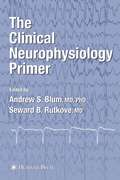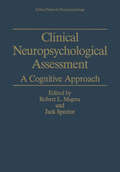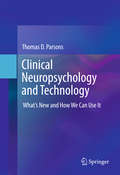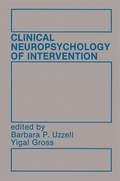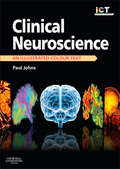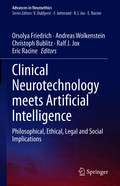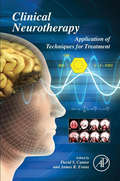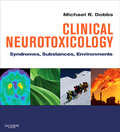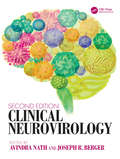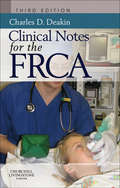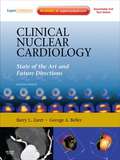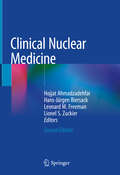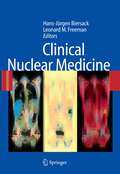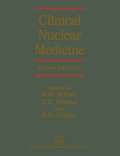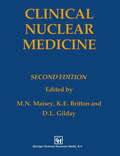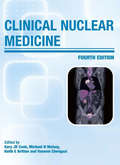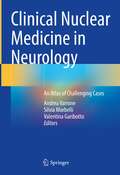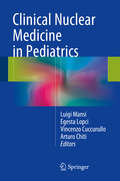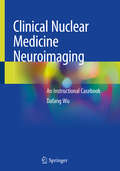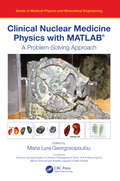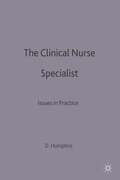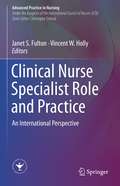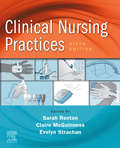- Table View
- List View
The Clinical Neurophysiology Primer
by Andrew S. Blum Seward B. RutkoveThis book presents a broad yet focused treatment of central topics in the field of clinical neurophysiology. The volume was inspired by the clinical neurophysiology lecture series at Beth Israel-Deaconess Medical Center and Rhode Island Hospital. Much like the lecture series, this book is designed to acquaint trainees with the essential elements of clinical neurophysiology. Each chapter is written by leading and respected clinical neurophysiologists.
Clinical Neuropsychological Assessment: A Cognitive Approach (Critical Issues in Neuropsychology)
by JackSpector Robert L. MapouPracticing neuropsychologists and students in clinical neuropsychology must increas ingly cross disciplinary boundaries to understand and appreciate the neuroanatomical, neurophysiological, and neuropharmacological bases of cognition and behavior, cur rent cognitive theory in many different domains of functioning, and the nature and tools of clinical assessment. Although the cognitive functions and abilities of interest are often the same, each of these fields has grappled with them from sometimes very different perspectives. Terminology is often specific to a particular discipline or ap proach, methods are diverse, and the goals or outcomes of study or investigation are usually very different. This book poises itself to provide a largely missing link between traditional approaches to assessment and the growing area of cognitive neuropsy chology. Historically, neuropsychology had as its central core the consideration of evidence from clinical cases. It was the early work of neurologists such as Broca, Wernicke, Hughlings-Jackson, and Liepmann, who evaluated and described the behavioral cor relates of prescribed lesions in individual patients and focused investigation on the lateralization and localization of cognitive abilities in humans. An outgrowth of those approaches was the systematic development of experimental tasks that could be used to elucidate the nature of cognitive changes in individuals with well-described brain lesions.
Clinical Neuropsychology and Technology: What’s New and How We Can Use It
by Thomas D. ParsonsThis ambitious and accessible guide reviews innovative technologies enhancing the field of neuropsychological testing. Starting with the premise that standard batteries—some nearly a century old—lag behind in our era of neuroimaging, genomic studies, psychophysiology, and informatics, it presents digital measures offering more efficient administration, more accurate data, and wider clinical applications. Ecological validity and evidence-based science are key themes in these advances, from virtual environments and assessment of social cognition to the shift toward situational reliability and away from lab-created constructs. These chapters also demonstrate how high-tech assessment tools can complement or supplement traditional pencil-and-paper measures without replacing them outright.This book covers in depth:· The evolution of neuropsychological testing over the past century.· Current applications of computer-based neuropsychological assessments.· The strengths and limitations of simulation technology.· The use of teleneuropsychology in reaching remote clients.· The potential of gaming technologies in neurocognitive rehabilitation.· How technology can transform test data into information useful across specialties.Clinical Neuropsychology and Technology brings neuropsychologists, clinical psychologists, and rehabilitation specialists into the vanguard of assessment measures and processes that will translate into more accurate testing, collaborations between disciplines, and valid and useful outcomes.
Clinical Neuropsychology of Intervention
by YigalGross Barbara P. UzzellNeuropsychology has been concerned with brain-behavior relationships. Clinical neuropsychology has been concerned with application of relation ships to clinical problems. As interest in these topics continues, a spin-off from clinical neuropsychology has been the realization ofthe potential ofde lineations of behavioral consequences of cerebral lesions for developing and evaluating restoration and compensation objectives. Methods for these proce dures are scattered in books, journal articles, or else unwritten, and only in the minds of clinicians. Questions need to be addressed regarding the kinds ofassessment selections required; the types ofrehabilitation planning; the in fluences ofthe environment, communication, and personality; and the means of effectively evaluating rehabilitation procedures. A useful book is needed by clinicians working in this area. The purpose of this book is to consolidate, in one volume, current work able approaches ofa subdiscipline within neuropsychology and related areas which we are calling Intervention. Problems, dilemmas, solutions, and choices are presented to the reader beginning to work in this fascinating area, and to those of us already enthralled by previous developments and outcomes. Workers with expertise in assessment for intervention and interventiop strategies are chapter contributors who unravel issues, provide available em pirically based theory, illustrative data, and case reports. The volume begins with a chapter that emphasizes an awareness of the potential usefulness ofpathophysiology, and the recognition of spontaneous xv xvi recovery in relationship to intervention. Part II of the book is devoted to identifying and developing assessment techniques relevant for intervention.
Clinical Neuroscience E-Book (Illustrated Colour Text)
by Paul JohnsThis book provides a clear and readable introduction to the central concepts of clinical neuroscience. The first part of the book deals with fundamental areas of neuroscience required for a sound understanding of brain disease. This is followed by an account of the neurobiology of the most common and important brain diseases of the western world (stroke, epilepsy, Alzheimer's disease, Parkinson's disease and multiple sclerosis). The book is in the same general style as the successful Crossman: Neuronatomy with extensive colour illustrations.Short, affordable and readable introductory level text in the smae style as Crossman: Neuroanatomy.Assumes little previous neuroscience knowledge.Explains fundamental concepts without overwhelming detailFocuses on clinically relevant material.Includes the most common and important neurological disorders.
Clinical Neurotechnology meets Artificial Intelligence: Philosophical, Ethical, Legal and Social Implications (Advances in Neuroethics)
by Orsolya Friedrich Andreas Wolkenstein Christoph Bublitz Ralf J. Jox Eric RacineNeurotechnologies such as brain-computer interfaces (BCIs), which allow technical devices to be used with the power of thought or concentration alone, are no longer a futuristic dream or, depending on the viewpoint, a nightmare. Moreover, the combination of neurotechnologies and AI raises a host of pressing problems. Now that these technologies are about to leave the laboratory and enter the real world, these problems and implications can and should be scrutinized.This volume brings together scholars from a wide range of academic disciplines such as philosophy, law, the social sciences and neurosciences, and is unique in terms of both its focus and its methods. The latter vary considerably, and range from philosophical analysis and phenomenologically inspired descriptions to legal analysis and socio-empirical research. This diversified approach allows the book to explore the entire spectrum of philosophical, normative, legal and empirical dimensions of intelligent neurotechnologies. Philosophical and legal analyses of normative problems are complemented by a thorough empirical assessment of how BCIs and other forms of neurotechnology are being implemented, and what their measurable implications are. To take a closer look at specific neurotechnologies, a number of applications are addressed. Case studies, previously unidentified issues, and normative insights on these cases complement the rich portrait this volume provides. Clinicians, philosophers, lawyers, social scientists and engineers will greatly benefit from the collection of articles compiled in this book, which will likely become a standard reference work on the philosophy of intelligent neurotechnologies.
Clinical Neurotherapy: Application of Techniques for Treatment
by James R. Evans David S. CantorNeurotherapy, sometimes called EEG biofeedback and/or neurobiofeedback involves techniques designed to manipulate brain waves through non-invasive means and are used as treatment for a variety of psychological and medical disorders. The disorders covered include ADHD, mood regulation, addiction, pain, sleep disorders, and traumatic brain injury. This book introduces specific techniques, related equipment and necessary training for the clinical practitioner. Sections focus on treatment for specific disorders and which individual techniques can be used to treat the same disorder and examples of application and the evidence base for use are described. An introduction for clinical practitioners and psychologists investigating neurotherapy techniques and application Includes coverage of common disorders such as ADHD, mood regulation, addiction, pain, sleep disorders, and traumatic brain injury Includes evidence base for use Includes training methods for new users
Clinical Neurotoxicology E-Book: Syndromes, Substances, Environments (The\clinics)
by Michael R. DobbsClinical Neurotoxicology offers accurate, relevant, and comprehensive coverage of a field that has grown tremendously in the last 20 years. You’ll get a current symptomatic approach to treating disorders caused by neurotoxic agents, environmental factors—such as heavy metals and pesticides—and more. Apply discussions of cellular and molecular processes and pathology to clinical neurology. Leading authorities and up-and-coming clinical neurotoxicologists present their expertise on wide-ranging, global subjects and debate controversies in the specialty, including Gulf War Syndrome.Provides a complete listing of neurotoxic agents—from manufactured to environmental—so you get comprehensive, clinical coverage. Covers how toxins manifest themselves according to age and co-morbidity so that you can address the needs of all your patients. Offers broad and in-depth coverage of toxins from all over the world through contributions by leading authorities and up-and-coming clinical neurotoxicologists. Features discussion of controversial and unusual topics such as Gulf War Syndrome, Parkinson’s Disease, motor neuron disease, as well as other issues that are still in question.
Clinical Neurovirology
by Avindra Nath; Joseph R. BergerThis is a comprehensive reference that includes the basic science, clinical features, imaging, pathology and treatment of specific viral entities affecting the central nervous system (CNS). It will assist professionals in their attempt to identify, examine and manage viral CNS infections and unravel the therapeutic and diagnostic challenges associated with viral CNS disorders. Key Features Features MRI scans, histopathology and lined diagrams showing pathophysiology Much has happened in our understanding of CNS infections in recent years and a comprehensive book that covers the entire subject is much needed. There is ongoing interest in infectious disease. The increasing globalization of medicine is putting demands on many more people to become familiar with issues from around that world that they did not see in training.
Clinical Neurovirology
by Avindra Nath Joseph R. BergerThis is a comprehensive reference that includes the basic science, clinical features, imaging, pathology and treatment of specific viral entities affecting the central nervous system (CNS). It will assist professionals in their attempt to identify, examine and manage viral CNS infections and unravel the therapeutic and diagnostic challenges associated with viral CNS disorders. Key Features Features MRI scans, histopathology and lined diagrams showing pathophysiology Much has happened in our understanding of CNS infections in recent years and a comprehensive book that covers the entire subject is much needed. There is ongoing interest in infectious disease. The increasing globalization of medicine is putting demands on many more people to become familiar with issues from around that world that they did not see in training.
Clinical Notes for the FRCA E-Book (FRCA Study Guides)
by Charles DeakinNew edition of a successful book of concise notes on clinical aspects of the examination for the Fellowship of the Royal College of Anaethetists. It has been fully updated to reflect changes in the examination syllabus. This will be an ideal revision guide for trainee anaesthetists sitting the FRCA and similar examinations.Concise notes for the clinical part of the FRCA.Appendix covers the up to date syllabus for the examination.Incudes appropriate guidelines and reports from the Association of Anaesthetists.Each section ends with list of further reading.
Clinical Nuclear Cardiology: State Of The Art And Future Directions
by Barry L. Zaret George A. BellerClinical Nuclear Cardiology—now in its fourth edition—covers the tremendous clinical growth in this field, focusing on new instrumentation and techniques. Drs. Barry L. Zaret and George A Beller address the latest developments in technology, radiopharmaceuticals, molecular imaging, and perfusion imaging. Thoroughly revised to include 20 new chapters—Digital/Fast SPECT, Imaging in Revascularized Patients, and more—this new edition provides state-of-the-art guidance on key areas and hot topics with stunning visuals. Online access to the fully searchable text at expertconsult.com includes highly illustrated case studies that let you see the problem using a variety of imaging modalities. In other words, this is an invaluable resource no clinician or researcher in nuclear cardiology should be without.Features an editorial and contributing team of worldwide leaders in nuclear cardiology to provide you with current and authoritative guidance. Includes a section focusing on acute coronary syndromes to provide you with practical management tools for these conditions. Presents a full-color design that allows color images to be integrated throughout the text. Includes access to the fully searchable contents of the book online at expertconsult.com, along with highly illustrated case studies that let you see the problem using a variety of imaging modalities. Features 20 new chapters including Cellular Mechanisms of Tracer Uptake and Clearance; Attenuation/Scatter Corrections: Clinical Aspects; Hybrid Imaging; Digital/Fast SPECT; Imaging in Revascularized Patients; and more. Focuses on perfusion imaging in a section dedicated to this hot topic so you get all the information you need to stay current.
Clinical Nuclear Medicine
by Hojjat Ahmadzadehfar Hans-Jürgen Biersack Leonard M. Freeman Lionel S. ZuckierIn the new edition of this very successful book, European and North American experts present the state of the art in diagnostic and therapeutic radionuclide procedures. The aim is to examine established and emerging clinical applications in detail, rather than to consider everything included in the comprehensive texts already available within the field. This “practical” approach ensures that the book will be a valuable guide for nuclear medicine physicians, technologists, students, and interested clinicians alike. This edition of Clinical Nuclear Medicine has been extensively revised to take account of recent developments. The roles of SPECT/CT, PET/CT, and PET/MRI are clearly explained and illustrated, and the coverage extended to encompass, for example, novel PET tracers and therapeutic radionuclides, advanced techniques of brain imaging, and the development of theranostics. Readers will be fully persuaded of the ever-increasing value of nuclear medicine techniques in depicting physiology and function and complementing anatomic modalities such as CT, MRI, and ultrasound.
Clinical Nuclear Medicine
by Hans-Jürgen Biersack Leonard M. FreemanThis work has true international scope, being a unique European/American joint venture that focuses on the state of the art in both diagnostic and therapeutic radionuclide methodology. Pertinent clinical applications are emphasized rather than attempting to cover everything included in the several large comprehensive texts available in our field. This "practical" approach should make it an essential guide to nuclear medicine physicians, technologists, students and interested clinicians alike.
Clinical Nuclear Medicine
by K. E. Britton David Collier Michael Maisey Q. H. SirajNuclear medicine is the bridge between a particular clinical problem and a relevant test using radionuclides. It began as a minor technical tool used in a few branches of medicine, notably endocrinology and nephrology. However, throughout the world it has now become established as a clinical discipline in its own right, with specific training programmes, special skills and a particular approach to patient management. Although the practising nuclear medicine physician must necessarily learn a great deal of basic science and technology, a sound medical training and a clinical approach to the subject remains of fundamental importance. It is for this reason that we have attempted in this book to approach the subject from a clinical standpoint, including where necessary relevant physiological material. There exist many excellent texts which cover the basic science and technology of nuclear medicine. We have, therefore, severely limited our coverage of these aspects of the subject to matters which we felt to be essential, particularly those which have been less well covered in other texts - for example, the contents of Chapter 21 on Quantitation by Royal and McNeil. Similarly, we have included at the end of some chapters descriptions of particular techniques where we and the authors felt that it would be helpful. In order to emphasize the clinical approach of this book we have inverted the traditional sequence of material in chapters, presenting the clinical problems first in each instance.
Clinical Nuclear Medicine
by K. E. Britton David L. Gilday Michael MaiseyNuclear medicine is the bridge between a particular clinical problern and a relevant test using radionuclides. It began as a minor technical tool used in a few branches of medicine, notably endocrinology and nephrology. However, throughout the world it has now become established as a clinical discipline in its own right, with specific training programmes, special skills and a particular approach to patient management. Although the practising nuclear medicine physician must necessarily learn a great deal of basic science and technology, a sound medical training and a clinical approach to the subject remains of fundamental importance. It is for this reason that we have attempted in this book to approach the subject from a clinical standpoint, including where necessary relevant physiological material. There exist many excellent texts which cover the basic science and technology of nuclear medicine. We have, therefore, severely limited our coverage of these aspects of the subject to matters which we felt tobe essential, particularly those which have been less well covered in other texts- for example, the contents of Chapter 20 on Measurement by Royal and McNeill. Similarly, we have limited details of methodology to skeletal summaries of protocol (Appendix 1) and have included at the end of some chapters descriptions of particular techniques where we and the authors felt that it would be helpful.
Clinical Nuclear Medicine
by Gary J.R Cook M. N Maisey Vaseem ChengaziThe fourth edition of Clinical Nuclear Medicine highlights the continued growth in clinical applications for PET and other aspects of molecular imaging. With its problem-oriented clinical approach, the book presents relevant topics of current importance to the practicing clinician rather than providing a comprehensive review of all technical a
Clinical Nuclear Medicine in Neurology: An Atlas of Challenging Cases
by Andrea Varrone Silvia Morbelli Valentina GaribottoThis book gathers a collection of cases with challenging diagnoses, in which nuclear medicine examinations have been particularly helpful in terms of the final diagnosis or follow-up. The cases presented chiefly involve patients with neurodegenerative disorders, epilepsy and brain tumors. The book is intended for nuclear medicine specialists as well as clinicians, offering essential guidance on the interpretation of neurology cases in the clinical setting, particularly with regard to correctly interpreting diagnostic imaging procedures. The authors were selected from the members of the Neuroimaging Committee of the EANM and have extensive experience as clinicians and teachers within the Nuclear Medicine Community.
Clinical Nuclear Medicine in Pediatrics
by Luigi Mansi Egesta Lopci Vincenzo Cuccurullo Arturo ChitiThis book provides a comprehensive state-of-the-art review of pediatric nuclear medicine, encompassing both diagnostic and therapeutic applications. Detailed attention is paid to the role of FDG PET-CT within oncology, but a variety of other long-established or less frequently used diagnostic procedures are also covered. Each indication is critically discussed from a clinical perspective, with analysis of benefits and limitations and comparison against the information yield of alternative techniques. The coverage of therapy based on radiopharmaceuticals includes the most relevant current strategies, including those utilizing radioiodine, MIBG, or radiolabelled peptides. In addition, issues concerning the radiation risk of nuclear medicine procedures in children are addressed. All chapters have been written by international experts and include the most up-to-date scientific and clinical information.
Clinical Nuclear Medicine Neuroimaging: An Instructional Casebook
by Dafang WuThis book serves as a casebook for clinical nuclear medicine neuroimaging. Clinical interpretation of nuclear medicine neuroimaging studies is often challenging, mainly due to the complexity of neuroanatomy and a lack of supportive reference books. This is an unmet need in many teaching hospitals. Utilizing a hands-on, case-based approach, this textbook guides readers through clinical nuclear medicine neuroimaging of major neurological diseases and conditions, including dementia, epilepsy, and brain death. Included here are basic guidelines and techniques for nuclear medicine neuroimaging practices, set alongside case examples that include standardized imaging display and detailed interpretation. Each chapter begins with examples of normal brain imaging as a reference point for the remainder of the chapter, which then presents detailed case examples of these diseases through various imaging techniques. Each of the cases highlights clinical and imaging key findings and precise impressions. This is an ideal guide for residents, fellows, and even practicing nuclear medicine physicians as a reference and teaching tool for neuroimaging in clinical nuclear medicine. It will be of significant value to residents, trainees, and young physicians in preparation for their in-service tests and board examinations.
Clinical Nuclear Medicine Physics with MATLAB®: A Problem-Solving Approach (Series in Medical Physics and Biomedical Engineering)
by Maria Lyra GeorgosopoulouThe use of MATLAB® in clinical Medical Physics is continuously increasing, thanks to new technologies and developments in the field. However, there is a lack of practical guidance for students, researchers, and medical professionals on how to incorporate it into their work. Focusing on the areas of diagnostic Nuclear Medicine and Radiation Oncology Imaging, this book provides a comprehensive treatment of the use of MATLAB in clinical Medical Physics, in Nuclear Medicine. It is an invaluable guide for medical physicists and researchers, in addition to postgraduates in medical physics or biomedical engineering, preparing for a career in the field. In the field of Nuclear Medicine, MATLAB enables quantitative analysis and the visualization of nuclear medical images of several modalities, such as Single Photon Emission Computed Tomography (SPECT), Positron Emission Tomography (PET), or a hybrid system where a Computed Tomography system is incorporated into a SPECT or PET system or similarly, a Magnetic Resonance Imaging system (MRI) into a SPECT or PET system. Through a high-performance interactive software, MATLAB also allows matrix computation, simulation, quantitative analysis, image processing, and algorithm implementation. MATLAB can provide medical physicists with the necessary tools for analyzing and visualizing medical images. It is useful in creating imaging algorithms for diagnostic and therapeutic purposes, solving problems of image reconstruction, processing, and calculating absorbed doses with accuracy. An important feature of this application of MATLAB is that the results are completely reliable and are not dependent on any specific γ-cameras and workstations. The use of MATLAB algorithms can greatly assist in the exploration of the anatomy and functions of the human body, offering accurate and precise results in Nuclear Medicine studies. KEY FEATURES Presents a practical, case-based approach whilst remaining accessible to students Contains chapter contributions from subject area specialists across the field Includes real clinical problems and examples, with worked through solutions Maria Lyra Georgosopoulou, PhD, is a Medical Physicist and Associate Professor at the National and Kapodistrian University of Athens, Greece. Photo credit: The Antikythera Mechanism is the world’s oldest known analog computer. It consisted of many wheels and discs that could be placed onto the mechanism for calculations. It is possible that the first algorithms and analog calculations in mathematics were implemented with this mechanism, invented in the early first centuries BC. It has been selected for the cover to demonstrate the importance of calculations in science.
Clinical Nuclear Medicine Physics with MATLAB®: A Problem-Solving Approach (Series in Medical Physics and Biomedical Engineering)
by Maria Lyra GeorgosopoulouThe use of MATLAB® in clinical Medical Physics is continuously increasing, thanks to new technologies and developments in the field. However, there is a lack of practical guidance for students, researchers, and medical professionals on how to incorporate it into their work. Focusing on the areas of diagnostic Nuclear Medicine and Radiation Oncology Imaging, this book provides a comprehensive treatment of the use of MATLAB in clinical Medical Physics, in Nuclear Medicine. It is an invaluable guide for medical physicists and researchers, in addition to postgraduates in medical physics or biomedical engineering, preparing for a career in the field. In the field of Nuclear Medicine, MATLAB enables quantitative analysis and the visualization of nuclear medical images of several modalities, such as Single Photon Emission Computed Tomography (SPECT), Positron Emission Tomography (PET), or a hybrid system where a Computed Tomography system is incorporated into a SPECT or PET system or similarly, a Magnetic Resonance Imaging system (MRI) into a SPECT or PET system. Through a high-performance interactive software, MATLAB also allows matrix computation, simulation, quantitative analysis, image processing, and algorithm implementation. MATLAB can provide medical physicists with the necessary tools for analyzing and visualizing medical images. It is useful in creating imaging algorithms for diagnostic and therapeutic purposes, solving problems of image reconstruction, processing, and calculating absorbed doses with accuracy. An important feature of this application of MATLAB is that the results are completely reliable and are not dependent on any specific γ-cameras and workstations. The use of MATLAB algorithms can greatly assist in the exploration of the anatomy and functions of the human body, offering accurate and precise results in Nuclear Medicine studies. KEY FEATURES Presents a practical, case-based approach whilst remaining accessible to students Contains chapter contributions from subject area specialists across the field Includes real clinical problems and examples, with worked through solutions Maria Lyra Georgosopoulou, PhD, is a Medical Physicist and Associate Professor at the National and Kapodistrian University of Athens, Greece. Photo credit: The Antikythera Mechanism is the world’s oldest known analog computer. It consisted of many wheels and discs that could be placed onto the mechanism for calculations. It is possible that the first algorithms and analog calculations in mathematics were implemented with this mechanism, invented in the early first centuries BC. It has been selected for the cover to demonstrate the importance of calculations in science.
The Clinical Nurse Specialist
The Clinical Nurse Specialist (C.N.S.) works across a huge range of practice areas. Despite this, certain common issues arise, and it is these issues which are addressed in this book. Each contributor examines a different facet of the C.N.S. role, be it practitioner, educator, researcher or consultant. Discussion is linked to practice through the use of examples based on the writer's own experience. This is the first British text to deal with questions of common interest to the C.N.S. The intention is to raise the debate to the nature of the role and acknowledge the vital contribution Clinical Nurse Specialists have to make to the continuing development of the quality of individual nursing care.
Clinical Nurse Specialist Role and Practice: An International Perspective (Advanced Practice in Nursing)
by Janet S. Fulton Vincent W. HollyDeveloped under the direction of the International Council of Nurses (ICN), this book is part of a series exploring advanced practice globally. It is the first known volume to provide an international view of the advanced practice role of clinical nurse specialist (CNS). It features an in-depth examination of advanced speciality practice in nursing, and the advanced practice role of the clinical CNS. Content includes models of practice, core practice competencies, curricular recommendations, practice outcomes, and regulatory requirements related to scope of practice. The CNS role and practice as implemented in North America, Europe, Asia and Oceania are examined in the context of the country’s healthcare system, educational traditions and regulatory requirements. Exemplars describe role implementation in various specialty practices and discuss how the role is implemented to advance nursing and improve clinical and fiscal outcomes. Measurement and evaluation of CNS practice in the context of countries and health care systems are examined. For practicing CNSs, this book provides an in-depth examination of the role from the global perspective; for administrators it provides a foundational understanding of the CNS role and practice and performance expectations. Educators will use the book as a resource for curriculum development, whereas students will offers an expanded global view of the role. Advanced practice roles, including the CNS, are continuing to evolve. This book makes important contributions to a global understanding of the CNS role.
Clinical Nursing Practices: Guidelines for Evidence-Based Practice
by Elizabeth Jamieson Lesley A. Whyte Janice M. McCallThe new edition of Clinical Nursing Practices reflects the many changes in nurse education and practice. A team of clinical and education experts has updated the core practices contained within this text, while to ensure continuity the previous editors have acted as consultants in the development of this edition. To reflect the continuing evolution of nursing and nursing practice, this new 6th edition emphasizes the importance of evidence-based practice, values-based care, person centred care, health and social care integration and interprofessional education. To encourage reflective practice, self-assessment questions remain at the end of each chapter for some of the practices. Where appropriate, certain practices are evidenced mainly by National Guidelines and Standards such as Cardio Pulmonary Resuscitation, Infection Control and Blood Transfusion; consequently, the presentation of the skill or procedure reflects this. The updated text addresses the wider issues which impact on everyday nursing and healthcare practice and is specially written to meet the needs of nurses today. The core philosophy of book, however, remains the same: to encourage its readers to deliver the highest quality care to each individual patient, safely and effectively. Simple and straightforward step-by-step account of the key clinical procedures with clear learning outcomes. For nurses learning procedures for the first time, for newly qualified nurses needing to check their knowledge or for nurses returning to work needing an update or refresher. Equips readers to deliver high quality, safe and effective care to patients. References the new NMC standards of proficiency Updates to all chapters and skills New Action-Rationale format – clearly shows the reasons for performing each procedure. 25 new illustrations New editor team
